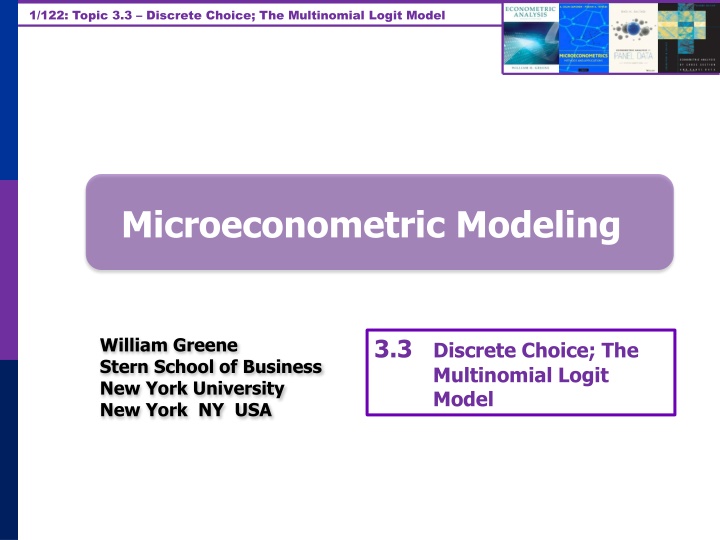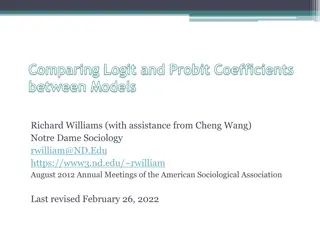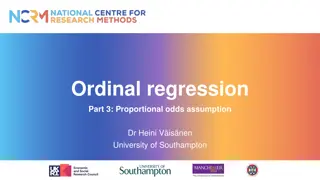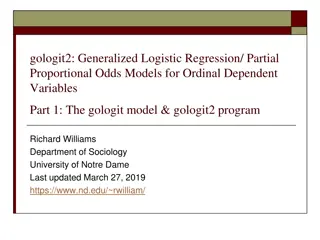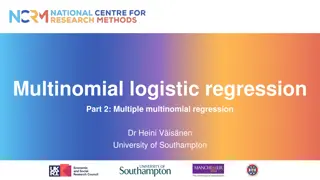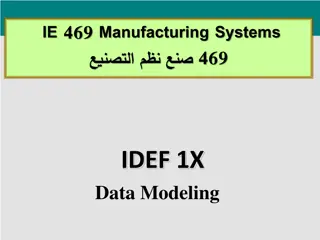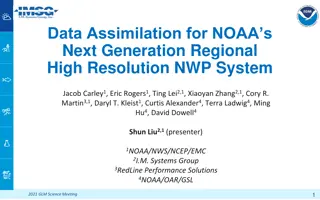Microeconometric Modeling with Multinomial Logit Model
The topic discusses the Multinomial Logit Model in the context of discrete choice modeling, covering concepts, models, consumer preferences, utility maximization, and implications for discrete choice models. It explores how consumers maximize utility under budget constraints, the need for well-defined utility indexes, and the translation of utilities into discrete choices. Various aspects such as random utility, revealed preferences, and heterogeneity in choices are highlighted.
Download Presentation

Please find below an Image/Link to download the presentation.
The content on the website is provided AS IS for your information and personal use only. It may not be sold, licensed, or shared on other websites without obtaining consent from the author.If you encounter any issues during the download, it is possible that the publisher has removed the file from their server.
You are allowed to download the files provided on this website for personal or commercial use, subject to the condition that they are used lawfully. All files are the property of their respective owners.
The content on the website is provided AS IS for your information and personal use only. It may not be sold, licensed, or shared on other websites without obtaining consent from the author.
E N D
Presentation Transcript
1/122: Topic 3.3 Discrete Choice; The Multinomial Logit Model Microeconometric Modeling William Greene Stern School of Business New York University New York NY USA 3.3 Discrete Choice; The Multinomial Logit Model
2/122: Topic 3.3 Discrete Choice; The Multinomial Logit Model Concepts Models Random Utility Multinomial Choice Attributes and Characteristics Stated and Revealed Preference Unlabeled Choice IID and IIA Consumer Surplus Choice Based Sampling Alternative Specific Constants Partial Effects and Elasticities Simulation WTP Space Hausman McFadden Test for IIA Random Regret Minimum Distance Estimator Scaled MNL Model Nonlinear Utility Functions Multinomial Logit Model Conditional Logit Fixed Effects Multinomial Logit Best/Worst Nested Logit Exploded Logit Heteroscedastic Extreme Value (HEV) Generalized Mixed Logit
3/122: Topic 3.3 Discrete Choice; The Multinomial Logit Model A Microeconomics Platform Consumers Maximize Utility (!!!) Fundamental Choice Problem: Maximize U(x1,x2, ) subject to prices and budget constraints A Crucial Result for the Classical Problem: Indirect Utility Function: V = V(p,I) Demand System of Continuous Choices V( ,I)/ I p V( ,I)/ p p j * j x =- Observed data usually consist of choices, prices, income The Integrability Problem: Utility is not revealed by demands
4/122: Topic 3.3 Discrete Choice; The Multinomial Logit Model Implications for Discrete Choice Models Theory is silent about discrete choices Translation of utilities to discrete choice requires: Well defined utility indexes: Completeness of rankings Rationality: Utility maximization Axioms of revealed preferences Consumers often act to simplify choice situations This allows us to build models. What common elements can be assumed? How can we account for heterogeneity? However, revealed choices do not reveal utility, only rankings which are scale invariant.
5/122: Topic 3.3 Discrete Choice; The Multinomial Logit Model Multinomial Choice Among J Alternatives Random Utility Basis Uitj = ij+ i xitj+ ijzit + ijt i = 1, ,N; j = 1, ,J(i,t); t = 1, ,T(i) N individuals studied, J(i,t) alternatives in the choice set, T(i) [usually 1] choice situations examined. Maximum Utility Assumption Individual i will Choose alternative j in choice setting t if and only if Uitj > Uitk for all k j. Underlying assumptions Smoothness of utilities Axioms of utility maximization: Transitive, Complete, Monotonic
6/122: Topic 3.3 Discrete Choice; The Multinomial Logit Model Features of Utility Functions The linearity assumption Uitj = ij + i xitj + j zit + ijt To be relaxed later: Uitj = V(xitj,zit, i) + ijt The choice set: Individual (i) and situation (t) specific Unordered alternatives j = 1, ,J(i,t) Deterministic (x,z, j) and random components ( ij, i, ijt) Attributes of choices, xitj and characteristics of the chooser, zit. Alternative specific constants ij may vary by individual Preference weights, i may vary by individual Individual components, j typically vary by choice, not by person Scaling parameters, ij = Var[ ijt], subject to much modeling
7/122: Topic 3.3 Discrete Choice; The Multinomial Logit Model Unordered Choices of 210 Travelers
8/122: Topic 3.3 Discrete Choice; The Multinomial Logit Model Data on Multinomial Discrete Choices
9/122: Topic 3.3 Discrete Choice; The Multinomial Logit Model Each person makes four choices from a choice set that includes either two or four alternatives. The first choice is the RP between two of the RP alternatives The second-fourth are the SP among four of the six SP alternatives. There are ten alternatives in total. A Stated Choice Experiment with Variable Choice Sets
10/122: Topic 3.3 Discrete Choice; The Multinomial Logit Model Stated Choice Experiment: Unlabeled Alternatives, One Observation t=1 t=2 t=3 t=4 t=5 t=6 t=7 t=8
11/122: Topic 3.3 Discrete Choice; The Multinomial Logit Model Unlabeled Choice Experiments This an unlabelled choice experiment: Compare Choice = (Air, Train, Bus, Car) To Choice = (Brand 1, Brand 2, Brand 3, None) Brand 1 is only Brand 1 because it is first in the list. What does it mean to substitute Brand 1 for Brand 2? What does the own elasticity for Brand 1 mean?
12/122: Topic 3.3 Discrete Choice; The Multinomial Logit Model The Multinomial Logit (MNL) Model Independent extreme value (Gumbel): F( itj) = Exp(-Exp(- itj)) (random part of each utility) Independence across utility functions Identical variances (means absorbed in constants) Same parameters for all individuals (temporary) Implied probabilities for observed outcomes P[choice = j| , ,i,t] = Prob[U U k = 1,...,J(i,t) x z ], itj it i,t,j i,t,k exp( + 'x + ' ) z j itj j it = J(i,t) exp( + ' x + ' ) z j itj j it j=1
13/122: Topic 3.3 Discrete Choice; The Multinomial Logit Model Specifying the Probabilities Choice specific attributes (X) vary by choices, multiply by generic coefficients. E.g., TTME=terminal time, GC=generalized cost of travel mode Generic characteristics (Income, constants) must be interacted with choice specific constants. Estimation by maximum likelihood; dij = 1 if person i chooses j P[choice = j| , ,i,t] = Prob[U U k = 1,...,J(i,t) x z ], itj it i,t,j i,t,k exp( + 'x + ' ) z j itj j it = J(i,t) exp( + ' x + ' ) z j itj j it j=1 i=1 N J(i) logL= d lo gP ij ij j=1
14/122: Topic 3.3 Discrete Choice; The Multinomial Logit Model Observed Data Types of Data Individual choice Market shares consumer markets Frequencies vote counts Ranks contests, preference rankings Attributes and Characteristics Attributes are features of the choices such as price Characteristics are features of the chooser such as age, gender and income. Choice Settings Cross section Repeated measurement (panel data) Stated choice experiments Repeated observations THE scanner data on consumer choices
15/122: Topic 3.3 Discrete Choice; The Multinomial Logit Model An Estimated MNL Model ----------------------------------------------------------- Discrete choice (multinomial logit) model Dependent variable Choice Log likelihood function -199.97662 Estimation based on N = 210, K = 5 Information Criteria: Normalization=1/N Normalized Unnormalized AIC 1.95216 409.95325 Fin.Smpl.AIC 1.95356 410.24736 Bayes IC 2.03185 426.68878 Hannan Quinn 1.98438 416.71880 R2=1-LogL/LogL* Log-L fncn R-sqrd R2Adj Constants only -283.7588 .2953 .2896 Chi-squared[ 2] = 167.56429 Prob [ chi squared > value ] = .00000 Response data are given as ind. choices Number of obs.= 210, skipped 0 obs --------+-------------------------------------------------- Variable| Coefficient Standard Error b/St.Er. P[|Z|>z] --------+-------------------------------------------------- GC| -.01578*** .00438 -3.601 .0003 TTME| -.09709*** .01044 -9.304 .0000 A_AIR| 5.77636*** .65592 8.807 .0000 A_TRAIN| 3.92300*** .44199 8.876 .0000 A_BUS| 3.21073*** .44965 7.140 .0000 --------+--------------------------------------------------
16/122: Topic 3.3 Discrete Choice; The Multinomial Logit Model Estimated MNL Model ----------------------------------------------------------- Discrete choice (multinomial logit) model Dependent variable Choice Log likelihood function -199.97662 Estimation based on N = 210, K = 5 Information Criteria: Normalization=1/N Normalized Unnormalized AIC 1.95216 409.95325 Fin.Smpl.AIC 1.95356 410.24736 Bayes IC 2.03185 426.68878 Hannan Quinn 1.98438 416.71880 R2=1-LogL/LogL* Log-L fncn R-sqrd R2Adj Constants only -283.7588 .2953 .2896 Chi-squared[ 2] = 167.56429 Prob [ chi squared > value ] = .00000 Response data are given as ind. choices Number of obs.= 210, skipped 0 obs --------+-------------------------------------------------- Variable| Coefficient Standard Error b/St.Er. P[|Z|>z] --------+-------------------------------------------------- GC| -.01578*** .00438 -3.601 .0003 TTME| -.09709*** .01044 -9.304 .0000 A_AIR| 5.77636*** .65592 8.807 .0000 A_TRAIN| 3.92300*** .44199 8.876 .0000 A_BUS| 3.21073*** .44965 7.140 .0000 --------+--------------------------------------------------
17/122: Topic 3.3 Discrete Choice; The Multinomial Logit Model Model Fit Based on Log Likelihood Three sets of predicted probabilities No model: Pij = 1/J (.25) Constants only: Pij = (1/N) i dij (58,63,30,59)/210=.286,.300,.143,.281 Constants only model matches sample shares Estimated model: Logit probabilities Compute log likelihood Measure improvement in log likelihood with Pseudo R-squared = 1 LogL/LogL0 ( Adjusted for number of parameters in the model.)
18/122: Topic 3.3 Discrete Choice; The Multinomial Logit Model Fit the Model with Only ASCs If the choice set varies across observations, this is the only way to obtain the restricted log likelihood. ----------------------------------------------------------- Discrete choice (multinomial logit) model Dependent variable Choice Log likelihood function -283.75877 Estimation based on N = 210, K = 3 Information Criteria: Normalization=1/N Normalized Unnormalized AIC 2.73104 573.51754 Fin.Smpl.AIC 2.73159 573.63404 Bayes IC 2.77885 583.55886 Hannan Quinn 2.75037 577.57687 R2=1-LogL/LogL* Log-L fncn R-sqrd R2Adj Constants only -283.7588 .0000-.0048 Response data are given as ind. choices Number of obs.= 210, skipped 0 obs --------+-------------------------------------------------- Variable| Coefficient Standard Error b/St.Er. P[|Z|>z] --------+-------------------------------------------------- A_AIR| -.01709 .18491 -.092 .9263 A_TRAIN| .06560 .18117 .362 .7173 A_BUS| -.67634*** .22424 -3.016 .0026 --------+-------------------------------------------------- If the choice set is fixed at J, then N N J j logL = log N l = 1 j J = log N P l j = 1 j
19/122: Topic 3.3 Discrete Choice; The Multinomial Logit Model Estimated MNL Model ----------------------------------------------------------- Discrete choice (multinomial logit) model Dependent variable Choice Log likelihood function -199.97662 Estimation based on N = 210, K = 5 Information Criteria: Normalization=1/N Normalized Unnormalized AIC 1.95216 409.95325 Fin.Smpl.AIC 1.95356 410.24736 Bayes IC 2.03185 426.68878 Hannan Quinn 1.98438 416.71880 R2=1-LogL/LogL* Log-L fncn R-sqrd R2Adj Constants only -283.7588 .2953 .2896 Chi-squared[ 2] = 167.56429 Prob [ chi squared > value ] = .00000 Response data are given as ind. choices Number of obs.= 210, skipped 0 obs --------+-------------------------------------------------- Variable| Coefficient Standard Error b/St.Er. P[|Z|>z] --------+-------------------------------------------------- GC| -.01578*** .00438 -3.601 .0003 TTME| -.09709*** .01044 -9.304 .0000 A_AIR| 5.77636*** .65592 8.807 .0000 A_TRAIN| 3.92300*** .44199 8.876 .0000 A_BUS| 3.21073*** .44965 7.140 .0000 --------+-------------------------------------------------- log log L L 2 Pseudo R = 1- . 0 N(J-1) N(J-1)-K log log L L 2 Adjusted Pseudo R =1- . 0
20/122: Topic 3.3 Discrete Choice; The Multinomial Logit Model Model Fit Based on Predictions Nj= actual number of choosers of j. Nfitj = iPredicted Probabilities for j Cross tabulate: Predicted vs. Actual, cell prediction is cell probability Predicted vs. Actual, cell prediction is the cell with the largest probability Njk = i dij Predicted P(i,k)
21/122: Topic 3.3 Discrete Choice; The Multinomial Logit Model Fit Measures Based on Crosstabulation +-------------------------------------------------------+ | Cross tabulation of actual choice vs. predicted P(j) | | Row indicator is actual, column is predicted. | | Predicted total is F(k,j,i)=Sum(i=1,...,N) P(k,j,i). | | Column totals may be subject to rounding error. | +-------------------------------------------------------+ NLOGIT Cross Tabulation for 4 outcome Multinomial Choice Model AIR TRAIN BUS CAR Total +-------------+-------------+-------------+-------------+-------------+ AIR | 32 | 8 | 5 | 13 | 58 | TRAIN | 8 | 37 | 5 | 14 | 63 | BUS | 3 | 5 | 15 | 6 | 30 | CAR | 15 | 13 | 6 | 26 | 59 | +-------------+-------------+-------------+-------------+-------------+ Total | 58 | 63 | 30 | 59 | 210 | +-------------+-------------+-------------+-------------+-------------+ NLOGIT Cross Tabulation for 4 outcome Constants Only Choice Model AIR TRAIN BUS CAR Total +-------------+-------------+-------------+-------------+-------------+ AIR | 16 | 17 | 8 | 16 | 58 | TRAIN | 17 | 19 | 9 | 18 | 63 | BUS | 8 | 9 | 4 | 8 | 30 | CAR | 16 | 18 | 8 | 17 | 59 | +-------------+-------------+-------------+-------------+-------------+ Total | 58 | 63 | 30 | 59 | 210 | +-------------+-------------+-------------+-------------+-------------+
22/122: Topic 3.3 Discrete Choice; The Multinomial Logit Model Partial effects: Change in attribute "k" of alternative "m" on the probability that the individual makes choice "j" j = Train x P Prob(j) x j = =P[ (j=m)-P ] 1 j m k m,k m,k m = Car k = Price
23/122: Topic 3.3 Discrete Choice; The Multinomial Logit Model k = Price Partial effects: Own effects: Prob(j) j = Train j = Train P x j = =P[1-P] j j k x j,k j,k m = Car Cross effects: Prob(j) x P j = =-PP j m k x m,k m,k
24/122: Topic 3.3 Discrete Choice; The Multinomial Logit Model Elasticities for proportional changes: logProb(j) = logx logx =[ (j=m)-P ] x 1 logP x j m,k P = P[ (j=m)-P ] 1 j m k m,k m,k j Note the elasticity is the same for all j. T consequence of the IIA assumption in the model specification made at the outset. m m,k k his is a
25/122: Topic 3.3 Discrete Choice; The Multinomial Logit Model +---------------------------------------------------+ | Elasticity averaged over observations.| | Attribute is INVT in choice AIR | | Mean St.Dev | | * Choice=AIR -.2055 .0666 | | Choice=TRAIN .0903 .0681 | | Choice=BUS .0903 .0681 | | Choice=CAR .0903 .0681 | +---------------------------------------------------+ | Attribute is INVT in choice TRAIN | | Choice=AIR .3568 .1231 | | * Choice=TRAIN -.9892 .5217 | | Choice=BUS .3568 .1231 | | Choice=CAR .3568 .1231 | +---------------------------------------------------+ | Attribute is INVT in choice BUS | | Choice=AIR .1889 .0743 | | Choice=TRAIN .1889 .0743 | | * Choice=BUS -1.2040 .4803 | | Choice=CAR .1889 .0743 | +---------------------------------------------------+ | Attribute is INVT in choice CAR | | Choice=AIR .3174 .1195 | | Choice=TRAIN .3174 .1195 | | Choice=BUS .3174 .1195 | | * Choice=CAR -.9510 .5504 | +---------------------------------------------------+ | Effects on probabilities of all choices in model: | | * = Direct Elasticity effect of the attribute. | +---------------------------------------------------+ Note the effect of IIA on the cross effects. Own effect Cross effects Elasticities are computed for each observation; the mean and standard deviation are then computed across the sample observations.
26/122: Topic 3.3 Discrete Choice; The Multinomial Logit Model Use Krinsky and Robb to compute standard errors for Elasticities
27/122: Topic 3.3 Discrete Choice; The Multinomial Logit Model Analyzing the Behavior of Market Shares to Examine Discrete Effects Scenario: What happens to the number of people who make specific choices if a particular attribute changes in a specified way? Fit the model first, then using the identical model setup, add ; Simulation = list of choices to be analyzed ; Scenario = Attribute (in choices) = type of change For the CLOGIT application ; Simulation = * ? This is ALL choices ; Scenario: GC(car)=[*]1.25$ Car_GC rises by 25%
28/122: Topic 3.3 Discrete Choice; The Multinomial Logit Model Model Simulation +---------------------------------------------+ | Discrete Choice (One Level) Model | | Model Simulation Using Previous Estimates | | Number of observations 210 | +---------------------------------------------+ +------------------------------------------------------+ |Simulations of Probability Model | |Model: Discrete Choice (One Level) Model | |Simulated choice set may be a subset of the choices. | |Number of individuals is the probability times the | |number of observations in the simulated sample. | |Column totals may be affected by rounding error. | |The model used was simulated with 210 observations.| +------------------------------------------------------+ ------------------------------------------------------------------------- Specification of scenario 1 is: Attribute Alternatives affected Change type Value --------- ------------------------------- ------------------- --------- GC CAR Scale base by value 1.250 ------------------------------------------------------------------------- The simulator located 209 observations for this scenario. Simulated Probabilities (shares) for this scenario: +----------+--------------+--------------+------------------+ |Choice | Base | Scenario | Scenario - Base | | |%Share Number |%Share Number |ChgShare ChgNumber| +----------+--------------+--------------+------------------+ |AIR | 27.619 58 | 29.592 62 | 1.973% 4 | |TRAIN | 30.000 63 | 31.748 67 | 1.748% 4 | |BUS | 14.286 30 | 15.189 32 | .903% 2 | |CAR | 28.095 59 | 23.472 49 | -4.624% -10 | |Total |100.000 210 |100.000 210 | .000% 0 | +----------+--------------+--------------+------------------+ Changes in the predicted market shares when GC_CAR increases by 25%.
29/122: Topic 3.3 Discrete Choice; The Multinomial Logit Model More Complicated Model Simulation In vehicle cost of CAR falls by 10% Market is limited to ground (Train, Bus, Car) CLOGIT ; Lhs = Mode ; Choices = Air,Train,Bus,Car ; Rhs = TTME,INVC,INVT,GC ; Rh2 = One ,Hinc ; Simulation = TRAIN,BUS,CAR ; Scenario: GC(car)=[*].9$
30/122: Topic 3.3 Discrete Choice; The Multinomial Logit Model Model Estimation Step ----------------------------------------------------------- Discrete choice (multinomial logit) model Dependent variable Choice Log likelihood function -172.94366 Estimation based on N = 210, K = 10 R2=1-LogL/LogL* Log-L fncn R-sqrd R2Adj Constants only -283.7588 .3905 .3807 Chi-squared[ 7] = 221.63022 Prob [ chi squared > value ] = .00000 Response data are given as ind. choices Number of obs.= 210, skipped 0 obs --------+-------------------------------------------------- Variable| Coefficient Standard Error b/St.Er. P[|Z|>z] --------+-------------------------------------------------- TTME| -.10289*** .01109 -9.280 .0000 INVC| -.08044*** .01995 -4.032 .0001 INVT| -.01399*** .00267 -5.240 .0000 GC| .07578*** .01833 4.134 .0000 A_AIR| 4.37035*** 1.05734 4.133 .0000 AIR_HIN1| .00428 .01306 .327 .7434 A_TRAIN| 5.91407*** .68993 8.572 .0000 TRA_HIN2| -.05907*** .01471 -4.016 .0001 A_BUS| 4.46269*** .72333 6.170 .0000 BUS_HIN3| -.02295 .01592 -1.442 .1493 --------+-------------------------------------------------- Alternative specific constants and interactions of ASCs and Household Income
31/122: Topic 3.3 Discrete Choice; The Multinomial Logit Model +---------------------------------------------+ | Discrete Choice (One Level) Model | | Model Simulation Using Previous Estimates | | Number of observations 210 | +---------------------------------------------+ +------------------------------------------------------+ |Simulations of Probability Model | |Model: Discrete Choice (One Level) Model | |Simulated choice set may be a subset of the choices. | |Number of individuals is the probability times the | |number of observations in the simulated sample. | |The model used was simulated with 210 observations.| +------------------------------------------------------+ ------------------------------------------------------------------------- Specification of scenario 1 is: Attribute Alternatives affected Change type Value --------- ------------------------------- ------------------- --------- INVC CAR Scale base by value .900 ------------------------------------------------------------------------- The simulator located 210 observations for this scenario. Simulated Probabilities (shares) for this scenario: +----------+--------------+--------------+------------------+ |Choice | Base | Scenario | Scenario - Base | | |%Share Number |%Share Number |ChgShare ChgNumber| +----------+--------------+--------------+------------------+ |TRAIN | 37.321 78 | 35.854 75 | -1.467% -3 | |BUS | 19.805 42 | 18.641 39 | -1.164% -3 | |CAR | 42.874 90 | 45.506 96 | 2.632% 6 | |Total |100.000 210 |100.000 210 | .000% 0 | +----------+--------------+--------------+------------------+ Model Simulation Step
32/122: Topic 3.3 Discrete Choice; The Multinomial Logit Model Willingness to Pay Generally a ratio of coefficients (Attribute Level) (Income) WTP = Use negative of cost coefficient as a proxu for MU of income negative (Attribute Level) (cost) WTP = Measurable using model parameters Ratios of possibly random parameters can produce wild and unreasonable values. We will consider a different approach later.
33/122: Topic 3.3 Discrete Choice; The Multinomial Logit Model Willingness to Pay U(alt) = aj + bINCOME*INCOME + bAttribute*Attribute + WTP = MU(Attribute)/MU(Income) When MU(Income) is not available, an approximation often used is MU(Cost). U(Air,Train,Bus,Car) = alt + cost Cost + INVT INVT + TTME TTME + alt WTP for less in vehicle time = - INVT / COST WTP for less terminal time = - TIME / COST
34/122: Topic 3.3 Discrete Choice; The Multinomial Logit Model WTP from CLOGIT Model ----------------------------------------------------------- Discrete choice (multinomial logit) model Dependent variable Choice --------+-------------------------------------------------- Variable| Coefficient Standard Error b/St.Er. P[|Z|>z] --------+-------------------------------------------------- GC| -.00286 .00610 -.469 .6390 INVT| -.00349*** .00115 -3.037 .0024 TTME| -.09746*** .01035 -9.414 .0000 AASC| 4.05405*** .83662 4.846 .0000 TASC| 3.64460*** .44276 8.232 .0000 BASC| 3.19579*** .45194 7.071 .0000 --------+-------------------------------------------------- WALD ; fn1=WTP_INVT=b_invt/b_gc ; fn2=WTP_TTME=b_ttme/b_gc$ ----------------------------------------------------------- WALD procedure. --------+-------------------------------------------------- Variable| Coefficient Standard Error b/St.Er. P[|Z|>z] --------+-------------------------------------------------- WTP_INVT| 1.22006 2.88619 .423 .6725 WTP_TTME| 34.0771 73.07097 .466 .6410 --------+-------------------------------------------------- Very different estimates suggests this might not be a very good model.
35/122: Topic 3.3 Discrete Choice; The Multinomial Logit Model Estimation in WTP Space Problem with WTP calculation: Ratio of two estimates that are asymptotically normally distributed may have infinite variance. Sample point estimates may be reasonable Inference - confidence intervals - may not be possible. WTP estimates often become unreasonable in random parameter models in which parameters vary across individuals. Estimation in WTP Space U(Air) = + COST + = + COST + For a simple MNL the transformation is 1:1. Results will be identical to the original model. In more elaborate, RP models, results change. TIME + Attr + COST TI ME attr = + Attr + attr TIME COST + TIME + COST COST COST Attr + TIME + COST TIME attr
36/122: Topic 3.3 Discrete Choice; The Multinomial Logit Model The I.I.D Assumption Uitj = ij+ xitj+ zit+ ijt F( itj) = Exp(-Exp(- itj)) (random part of each utility) Independence across utility functions Identical variances (means absorbed in constants) Restriction on equal scaling may be inappropriate Correlation across alternatives may be suppressed Equal cross elasticities is a substantive restriction Behavioral implication of IID is independence from irrelevant alternatives. If an alternative is removed, probability is spread equally across the remaining alternatives. This is unreasonable
37/122: Topic 3.3 Discrete Choice; The Multinomial Logit Model IIA Implication of IID exp[ ( U train )] U bus U train U bus dependent from air if air is U train + Prob(train) = exp[ ( )] exp[ ( + + )] exp[ ( exp[ ( )] exp[ ( + )] exp[ ( )] )] exp[ ( + )] U air U car Prob(train|train,bus,car) = exp[ ( Air is in the choice set, probabilities are in not in the condition. This is a testable behavioral assumption. )] U train U car
38/122: Topic 3.3 Discrete Choice; The Multinomial Logit Model Behavioral Implication of IIA +---------------------------------------------------+ | Elasticity averaged over observations.| | Attribute is INVT in choice AIR | | Mean St.Dev | | * Choice=AIR -.2055 .0666 | | Choice=TRAIN .0903 .0681 | | Choice=BUS .0903 .0681 | | Choice=CAR .0903 .0681 | +---------------------------------------------------+ | Attribute is INVT in choice TRAIN | | Choice=AIR .3568 .1231 | | * Choice=TRAIN -.9892 .5217 | | Choice=BUS .3568 .1231 | | Choice=CAR .3568 .1231 | +---------------------------------------------------+ | Attribute is INVT in choice BUS | | Choice=AIR .1889 .0743 | | Choice=TRAIN .1889 .0743 | | * Choice=BUS -1.2040 .4803 | | Choice=CAR .1889 .0743 | +---------------------------------------------------+ | Attribute is INVT in choice CAR | | Choice=AIR .3174 .1195 | | Choice=TRAIN .3174 .1195 | | Choice=BUS .3174 .1195 | | * Choice=CAR -.9510 .5504 | +---------------------------------------------------+ | Effects on probabilities of all choices in model: | | * = Direct Elasticity effect of the attribute. | +---------------------------------------------------+ Own effect Cross effects Note the effect of IIA on the cross effects. Elasticities are computed for each observation; the mean and standard deviation are then computed across the sample observations.
39/122: Topic 3.3 Discrete Choice; The Multinomial Logit Model A Hausman and McFadden Test for IIA Estimate full model with irrelevant alternatives Estimate the short model eliminating the irrelevant alternatives Eliminate individuals who chose the irrelevant alternatives Drop attributes that are constant in the surviving choice set. Do the coefficients change? Under the IIA assumption, they should not. Use a Hausman test: Chi-squared, d.f. Number of parameters estimated ) ' ( ( ) -1 H= - - - b b short V V b b short full full short full
40/122: Topic 3.3 Discrete Choice; The Multinomial Logit Model IIA Test for Choice AIR +--------+--------------+----------------+--------+--------+ |Variable| Coefficient | Standard Error |b/St.Er.|P[|Z|>z]| +--------+--------------+----------------+--------+--------+ GC | .06929537 .01743306 3.975 .0001 TTME | -.10364955 .01093815 -9.476 .0000 INVC | -.08493182 .01938251 -4.382 .0000 INVT | -.01333220 .00251698 -5.297 .0000 AASC | 5.20474275 .90521312 5.750 .0000 TASC | 4.36060457 .51066543 8.539 .0000 BASC | 3.76323447 .50625946 7.433 .0000 +--------+--------------+----------------+--------+--------+ GC | .53961173 .14654681 3.682 .0002 TTME | -.06847037 .01674719 -4.088 .0000 INVC | -.58715772 .14955000 -3.926 .0001 INVT | -.09100015 .02158271 -4.216 .0000 TASC | 4.62957401 .81841212 5.657 .0000 BASC | 3.27415138 .76403628 4.285 .0000 Matrix IIATEST has 1 rows and 1 columns. 1 +-------------- 1| 33.78445 Test statistic +------------------------------------+ | Listed Calculator Results | +------------------------------------+ Result = 9.487729 Critical value IIA is rejected
41/122: Topic 3.3 Discrete Choice; The Multinomial Logit Model
42/122: Topic 3.3 Discrete Choice; The Multinomial Logit Model
43/122: Topic 3.3 Discrete Choice; The Multinomial Logit Model
44/122: Topic 3.3 Discrete Choice; The Multinomial Logit Model
45/122: Topic 3.3 Discrete Choice; The Multinomial Logit Model
46/122: Topic 3.3 Discrete Choice; The Multinomial Logit Model
47/122: Topic 3.3 Discrete Choice; The Multinomial Logit Model Fixed Effects Multinomial Logit: Application of Minimum Distance Estimation
48/122: Topic 3.3 Discrete Choice; The Multinomial Logit Model Binary Logit Conditional Probabiities it + x e + i = = x Prob( 1| ) . y it it it + x 1 e i T i = = = Prob , , , Y y Y y Y y y 1 1 2 2 i i i i iT iT it i i = 1 t T T i i it it x x exp exp y y it it = = 1 1 t t = = . T T i i it i x x exp exp d d it T S can equal S i All ways that different it it t = t i d S t i i = = 1 1 t t d t i Denominator is summed over all the different combinations of T values of y that sum to the same sum as the observed T i T t=1 . If S is this sum, y i it i it there are terms. May be a huge number. An algorithm by Krailo S i and Pike makes it simple.
49/122: Topic 3.3 Discrete Choice; The Multinomial Logit Model Example: Seven Period Binary Logit y X Prob[ = (1,0,0,0,1,1,1)| exp( 1 exp( There are 35 different sequences of y (permutations) that sum to 4. ]= 1 + i + + x x ) exp( 1 exp( + ) ... 1 7 x i + i + + ) 1 exp( + x x ) ) 1 2 7 i i i it * it p= For example, y might b e (1,1,1,1,0,0,0). Etc. | 1 7 t x exp y = 1 it it 7 t X Prob[y=(1,0,0,0,1,1,1)| , y =7] = it = 1 i 35 7 t * it p x exp y = 1 | it = 1 p
50/122: Topic 3.3 Discrete Choice; The Multinomial Logit Model
